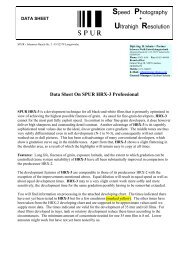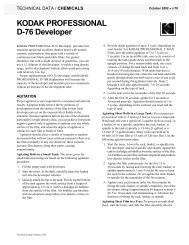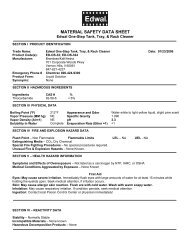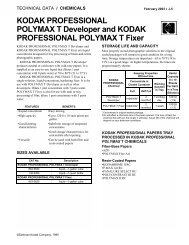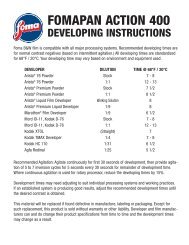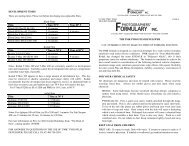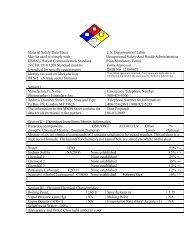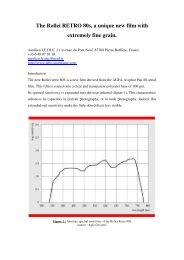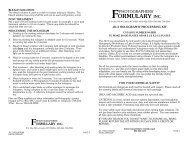Instructions & Technical Data (pdf)
Instructions & Technical Data (pdf)
Instructions & Technical Data (pdf)
You also want an ePaper? Increase the reach of your titles
YUMPU automatically turns print PDFs into web optimized ePapers that Google loves.
CATALOG NUMBER 01-0080 TO MAKE 10 LITERS<br />
PHOTOGRAPHERS'<br />
FORMULARY<br />
FORMULARY FX-1 HIGH ACUTANCE FILM DEVELOPER<br />
Formulary FX-1, originally formulated by Geoffrey W. Crawley, editor of the British Journal of<br />
Photography, is designed to produce negatives with maximum acutance or sharpness. The negatives will have<br />
a long tonal scale and are exceptionally easy to print. The print impact is impressive and often seems to have<br />
an “engraving-like” effect because of the high acutance of the negative. To achieve these effects to formula<br />
is designed to have chemical mechanism which deliberately enhances edge contrast and provokes adjacency<br />
effects.<br />
FX-1 produces negatives with slightly more grain than D-76 does. The grain is not very apparent because of<br />
the extreme details contained in the negative. Grain can be kept to a minimum by careful exposure and<br />
processing. FX-1 increases film speed by one F-stop. A superior negative can be obtained by using a slow<br />
film developed in FX-1 than can be obtained by developing a fast film in a fine grain developer.<br />
A note of caution - developer FX-1 enhances both resolution and poor photographic techniques. Be sure to<br />
use a first class modern multicoated lens, high shutter speeds, a tripod, and accurate exposures.<br />
CHEMICAL SAFETY<br />
All chemicals are dangerous and must be treated with respect. Please read the warning label on each package.<br />
Some individuals become sensitized (develop allergic symptoms or rashes) when using metol. If this should<br />
happen, discontinue use and see a physician.<br />
The user assumes all risks upon accepting these chemicals. IF FOR ANY REASON YOU DO NOT WISH<br />
TO ASSUME ALL RISKS, PLEASE RETURN THE CHEMICALS WITHIN THIRTY DAYS FOR A<br />
FULL REFUND.<br />
MIXING THE STOCK SOLUTIONS<br />
FOR BEST RESULTS USE DISTILLED WATER.<br />
You will need two 1 liter bottles, one of which should be brown and a wide-mouth 1 liter container. Stock<br />
solution A should be made with water that has been boiled for 3 minutes then cooled to about 32° C/90° F,<br />
or distilled water heated to approximately 32° C/90° F.<br />
STOCK SOLUTION A<br />
Chemical<br />
Amount<br />
Distilled Water (32° C/90° F)<br />
900 ml<br />
Sodium sulfite, anhydrous<br />
50 g<br />
Metol<br />
5 g<br />
Potassium Iodide Solution<br />
10 ml<br />
Distilled water to make<br />
1000 ml<br />
Potassium Iodide Solution: The original formula published in the British Journal of Photography<br />
calls for 50 ml of a 0.001% solution of potassium iodide. When exactly 10 ml of the potassium iodide<br />
solution supplied with this kit is added to the stock solution, it will be the equivalent of adding the 50 ml of<br />
0.001% solution. This 10 ml vial contains 0.0005 grams of potassium iodide in solution.
Before preparing the solution, either use distilled water or boil the water that you will need and allow it to<br />
cool to about 32° C/90° F. Boiling degasses the water and minimizes the initial oxidation of the metol.<br />
Place 900 ml of water in the mixing container and add a pinch of the sodium sulfite. This small amount of<br />
sulfite minimizes the initial oxidation of the metol. If more sulfite is added at this time the metol will not<br />
dissolve.<br />
Add the metol to the solution and stir to dissolve the metol. Add the sodium sulfite and stir until dissolved.<br />
Next, add the 10 ml of potassium iodide solution. Stir the stock solution, then finally add sufficient water to<br />
bring the total volume up to 1000 ml. Stir the solution to ensure it is mixed thoroughly. Transfer Stock<br />
Solution A to the brown bottle.<br />
STOCK SOLUTION B<br />
Chemical<br />
Amount<br />
Distilled Water (32° C/90° F)<br />
900 ml<br />
Sodium Carbonate, anhydrous<br />
25 g<br />
Distilled water to make<br />
1000 ml<br />
Add the water to the storage container followed by the carbonate. Cap and shake the container to dissolve the<br />
solid. Add water to bring the final volume up to 1000 ml.<br />
LIFE OF THE SOLUTION<br />
The shelf life of Stock Solution A is one year in a full tightly capped bottle, but considerably less in a halffull<br />
bottle. For long-term storage, it is best to keep the solution in several full small bottles. The shelf life can<br />
also be improved by adding 50 ml of isopropyl alcohol just prior to the final dilution to 1000 ml. This<br />
addition will also decrease development time and the amount of agitation that should be used.<br />
The shelf life of Stock Solution B is also one year. However, the solution is alkaline and upon extended<br />
storage will etch the glass of the container. If an extended storage time is anticipated, it is best to store<br />
Solution B in a plastic bottle.<br />
USING THE DEVELOPER<br />
Film Exposure - film developed in FX-1 will have an E.I. approximately twice that of the manufacturer’s<br />
recommended ASA. You will need careful testing to determine your exact E.I.<br />
MIXING THE WORKING SOLUTION<br />
All solutions should be at 20° C/ 68° F. The working solution is prepared with 1 part of Stock A, 1 part of<br />
Stock B and 8 parts of water.<br />
The working solution must be used immediately after mixing and can be used only once.<br />
Solution<br />
To Make<br />
1/2 liter 1 liter<br />
Stock Solution A 50 ml 100 ml<br />
Stock Solution B 50 ml 100 ml<br />
Water 400 ml 800 ml<br />
DEVELOPMENT<br />
Careful testing should be carried out to determine your exact development time for your film. Recommended<br />
times range from 12-16 minutes.<br />
Do not over agitate when developing with FX-1. Best results are obtained using 5 inversions or 6-8 spiral<br />
twists per minute with tanks up to 3000 ml capacity or 10-12 spiral twists per minute with larger tanks.<br />
FX-1 HIGH ACUTANCE DEVELOPER PHOTOGRAPHERS’ FORMULARY PAGE 2<br />
CAT. NO. 01-0080 800-922-5255
To exaggerate edge effects agitate every other minute and increase development time by about one third.<br />
Follow your normal development procedure: develop, stop, fix, wash, clear and wash.<br />
PHOTOGRAPHERS'<br />
FORMULARY INC.<br />
PO Box 950 • Condon MT 59826 • 406-754-2891 • FAX 406-754-2896<br />
E-MAIL formulary @montana.com<br />
FX-1 HIGH ACUTANCE DEVELOPER PHOTOGRAPHERS’ FORMULARY PAGE 3<br />
CAT. NO. 01-0080 800-922-5255



